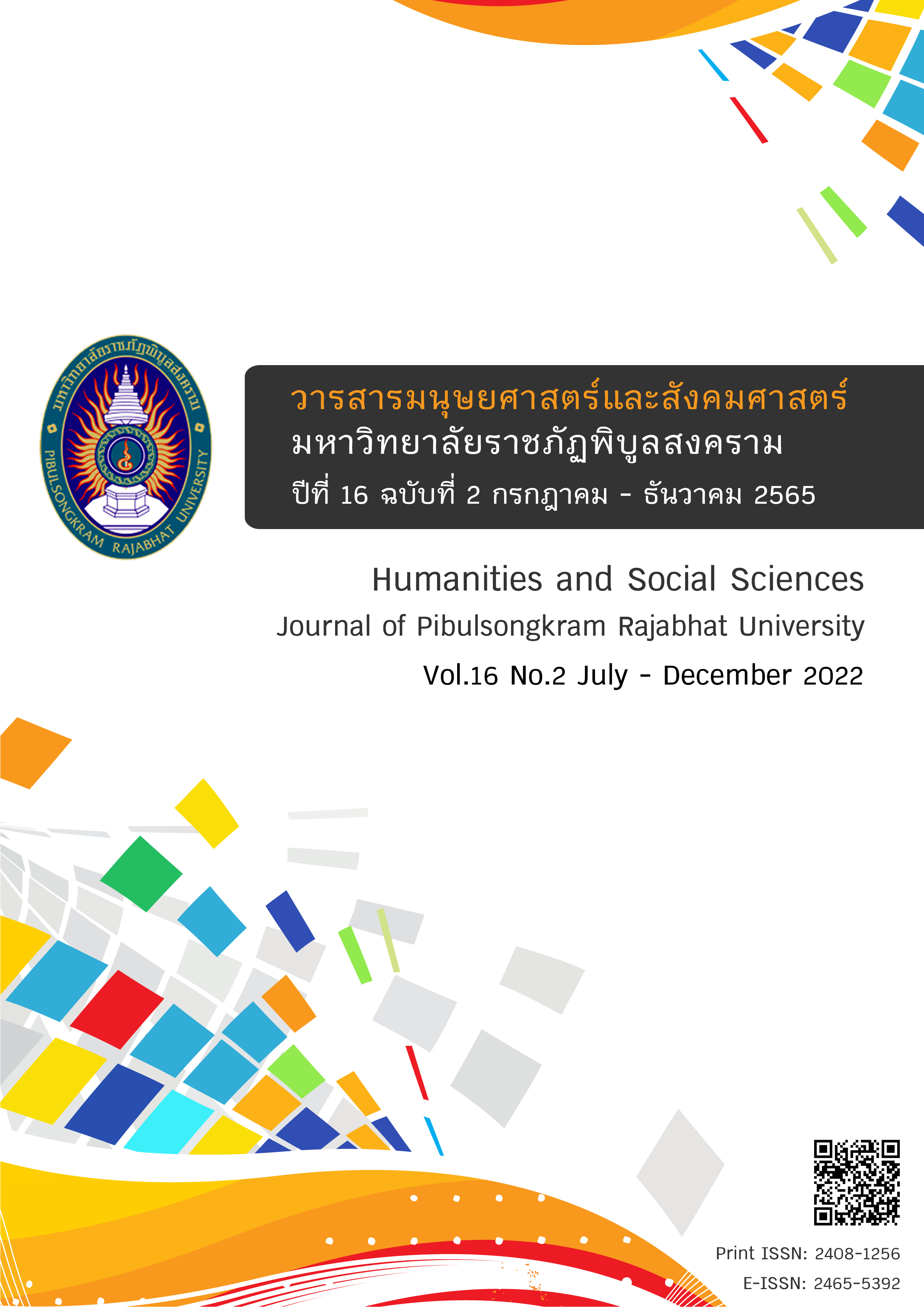Learning and Transferring Local Wisdom of Khanom Kong Making in Wat Chaiyo Worawihan Community, Ang Thong Province
DOI:
https://doi.org/10.14456/psruhss.2022.40Keywords:
Local wisdom, Khanom kong, Local curriculumAbstract
This research aimed to study about Khanom Kong, to develop a local wisdom curriculum in Khanom Kong making and to transfer a local curriculum of Khanom Kong local wisdom to members of the Chaiyo Worawiharn Temple community. The target groups for this research were the communities which own the wisdom of Khanom Kong making and distributing in the Chaiyo subdistrict municipality market and the Wat Chaiyo School students. The research tools were the note-taking form for local wisdom, the recipe form, the pre-test and post-test documents, and satisfaction survey form with in-depth interviews for the wisdom of Khanom Kong producing. Khanom Kong producing was demonstrated by VDO media and workshop for Mathayom 3 students of Wat Chaiyo School. Data of this research was analyzed by using content analysis techniques, statistics, frequency, percentage, means, standard deviation and t-test. The results found the knowledges of Khanom Kong cooking, the local wisdom in Chaiyo Sub-district, was received from the ancestors and learning by themself. Khanom Kong is one of fried dessert, the signature of Chaiyo Worawiharn temple community, which is 31⁄2 - 4 inches in diameter. It was made from roasted mung beans then soaked overnight, but it could be boiled instead. After that, it was mashed and stirred with coconut milk, coconut sugar, white grated coconut and glutinous rice flour. And then it was mixed until smooth, divided, rolled into long lines and shaped it looked like a circle. On the top, the mung bean paste was placed cross (Wheel shape). For the coating batter was prepared by glutinous rice flour or rice flour, duck egg, coconut milk, sugar and yeast flour, leavening agents sometimes mixed together. After that, wheel mung bean paste (Khanom Kong) was dipped in coating batter and deep fried until golden brown and crispy, drained on paper towels and served or packed in the container. For VDO media consisted of (1) 3 local methods from local wisdom of Khanom Kong, and (2) the 5 curriculums on 14 training hours. For knowledge transferring to Wat Chaiyo School students, found that the students' post-test score was statistically significantly higher than the pre-test score significance level at 0 .0 5 with the highest level of the satisfy level.
References
กรมการพัฒนาชุมชน กระทรวงมหาดไทย. (2556). แนวทางการดำเนินงานโครงการบันทึกและเผยแพร่ภูมิปัญญาท้องถิ่น ประจำปี 2556. กรุงเทพฯ: สำนักส่งเสริมภูมิปัญญาท้องถิ่นและวิสาหกิจชุมชน กรมการพัฒนาชุมชน กระทรวงมหาดไทย.
กองพัฒนาการศึกษานอกโรงเรียน กรมการศึกษานอกโรงเรียน. (2543). คู่มือการพัฒนาหลักสูตรท้องถิ่น. กรุงเทพฯ: กรมการศึกษานอกโรงเรียน.
โครงการสารานุกรมไทยสำหรับเยาวชน โดยพระราชประสงค์ในพระบาทสมเด็จพระเจ้าอยู่หัว. (2548). สารานุกรมไทยสำหรับเยาวชน เล่มที่ 19 (พิมพ์ครั้งที่ 7). กรุงเทพฯ: อัมรินทร์พริ้นติ้ง พับลิชชิ่ง.
จุฑามาศ พีรพัชระ, กันต์กนิษฐ์ ขวัญพฤกษ์, วรลักษณ์ ปัญญาธิติพงศ์, และสุวรรณ ประทีป ณ ถลาง. (2558). ตำรับอาหารไทยออนไลน์เพื่อเสริมสร้างสมรรถนะการเรียนรู้. กรุงเทพฯ: มหาวิทยาลัยเทคโนโลยีราชมงคลพระนคร.
ชลลดา ทวีคูณ, และจิราณีย์ พันมูล. (2558). การประยุกต์ใช้ภูมิปัญญาท้องถิ่นในมิติอาหารเพื่อสุขภาพ : กรณีศึกษาชุมชนไทยทรงดำ ตำบลไผ่หูช้าง อำเภอบางเลน จังหวัดนครปฐม. พระนครศรีอยุธยา: มหาวิทยาลัยเทคโนโลยีราชมงคลสุวรรณภูมิ.
บุญชม ศรีสะอาด. (2543). วิธีการสถิติสำหรับการวิจัย (พิมพ์ครั้งที่ 6). กรุงเทพฯ: สุรีริยาสาสน์การพิมพ์.
ประเวศ วะสี. (2534). การสร้างสรรค์ภูมิปัญญาไทยเพื่อการพัฒนา. กรุงเทพฯ: สำนักงานคณะกรรมการวัฒนธรรมแห่งชาติ.
มาริสา โกเศยะโยธิน. (2546). องค์ความรู้และการถ่ายทอดภูมิปัญญาพื้นบ้านในการทำนาข้าวด้วยวิธีเกษตรธรรมชาติ จังหวัดสุพรรณบุรี. กรุงเทพฯ: สำนักบริหารการศึกษานอกโรงเรียน กระทรวงศึกษาธิการ.
ยุพิน โมราทอง. (วันที่ 16 เมษายน 2558). ประธานวิสาหกิจชุมชนกลุ่มสตรีสหกรณ์เกษไชโย. สัมภาษณ์.
วชิร วาสนา, และกัญญา กำศิริพิมาน. (2555). การพัฒนาบรรจุภัณฑ์ขนมกง ตำบลหนองแก อำเภอเมืองอุทัยธานี. การประชุมเสนอผลงานวิจัยระดับบัณฑิตศึกษา มหาวิทยาลัยสุโขทัยธรรมาธิราช ครั้งที่ 2. นนทบุรี: มหาวิทยาลัยสุโขทัยธรรมาธิราช.
วณิชชา ณรงค์ชัย, ดุษฎี อายุวัฒน์, และอรนัดดา ชิณศรี. (2558). รูปแบบการถ่ายโอนทุนวัฒนธรรมระหว่างรุ่นวัยของครัวเรือนชนบทแห่งหนึ่งในภาคตะวันออกเฉียงเหนือ ประเทศไทย. ใน การประชุมวิชาการเสนอผลการวิจัยระดับบัณฑิตศึกษาแห่งชาติ ครั้งที่ 34 (น. 105 - 114). ขอนแก่น: มหาวิทยาลัยขอนแก่น.
วรรณษา แสนลำ, และนัฏฐา มณฑล. (2560). อาหารพื้นเมืองเพื่อสุขภาพที่ดี ชุมชนตำบลตลาด จังหวัดนครราชสีมา. วารสารวิจัยเพื่อการพัฒนาเชิงพื้นที่, 9(6), 445 - 457.
สามารถ จันทร์สูรย์. (2534). ภูมิปัญญาท้องถิ่นคืออะไร อย่างไร. การสัมมนาทางวิชาการ เรื่องภูมิปัญญาชาวบ้าน. กรุงเทพฯ: คุรุสภาลาดพร้าว.
สำนักงานจังหวัดอ่างทอง. (2556). แผนพัฒนาจังหวัดอ่างทอง พ.ศ. 2557-2560. อ่างทอง: สำนักงานจังหวัดอ่างทอง.
โสพิศ ขันทองดี. (2550). การศึกษาอาหารพื้นบ้านจังหวัดสุพรรณบุรี (วิทยานิพนธ์ปริญญาศิลปศาสตรมหาบัณฑิต). กรุงเทพฯ: มหาวิทยาลัยรามคำแหง.
อรพิน ทองดี, ปราโมทย์ จันทร์เรือง, และวาสนา วราภักต์. (2558). การพัฒนาหลักสูตรท้องถิ่น เรื่อง การทำขนมกง กลุ่มสาระการเรียนรู้การงานอาชีพและเทคโนโลยี สำหรับนักเรียนชั้นประถมศึกษาปีที่ 6 สำนักงานเขตพื้นที่การศึกษาประถมศึกษาสุพรรณบุรี เขต 3. ใน การประชุมวิชาการและนำเสนอผลการวิจัย ระดับชาติและนานาชาติ ครั้งที่ 6 กลุ่มระดับชาติ ด้านการศึกษา (น. 558 - 568). กรุงเทพฯ: มหาวิทยาลัยราชภัฏสวนสุนันทา.
อรอนงค์ ทองมี. (2558). วัฒนธรรมอาหารล้านนา : การพัฒนาเชิงเศรษฐกิจสร้างสรรค์. วารสารศิลปกรรมศาสตร์วิชาการวิจัยและงานสร้างสรรค์, 2(1), 25 - 54.
เอกวิทย์ ณ ถลาง. (2540). ภูมิปัญญาชาวบ้าน 4 ภูมิภาค : วิถีและกระบวนการเรียนรู้ของชาวบ้านไทย. นนทบุรี: โรงพิมพ์มหาวิทยาลัยสุโขทัยธรรมาธิราช.
Best, J. W. (1970). Research in Education (2nd ed.). Englewood Cliffs, New Jersey: Prentice Hall.
Jati, I. R. (2014). Local wisdom behind Tumpeng as an icon of Indonesian traditional cuisine. Nutrition & Food Science, 44(4), 324 - 334.
Malinowski, B. (1948). Magic, Science and Religion and Other Essays. Beacon Press: Boston, Massachusetts.
Downloads
Published
How to Cite
Issue
Section
License
Copyright (c) 2021 Humanities and Social Sciences Journal of Pibulsongkram Rajabhat University

This work is licensed under a Creative Commons Attribution-NonCommercial-NoDerivatives 4.0 International License.
Any articles or comments appearing in the Journal of Humanities and Social Sciences, Rajabhat Phibulsongkram University, are the intellectual property of the authors, and do not necessarily reflect the views of the editorial board. Published articles are copyrighted by the Journal of Humanities and Social Sciences, Rajabhat Phibulsongkram University.









